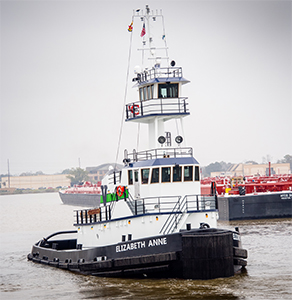Capt. Darren Grover, chief engineer Kenny Mooney and deck hand Zack Richardson slipped out of Jacksonville on Jan. 25 aboard the new Vane Brothers’ tug, Elizabeth Anne. A week later they arrived at the Conrad Orange Shipbuilding yard on the Sabine River in Orange, Texas, to pick up a new barge, Double Skin 315.
The winter weather along the way was worse than Grover expected, but the tug’s performance impressed him.
“For a time it was blowing a steady 35 knots with a 10-foot roll that was coming from a long way off, maybe Mexico,” said Grover. “We had waves coming up on the second deck. But the boat really rode very nicely. This boat has some steel in her. She’s very heavy but she is also very nimble.”
The 100-foot, 4,200-hp Elizabeth Anne is the first of eight tugs St. Johns Ship Building of Palatka, Fla., is building for Baltimore-based Vane Brothers. Home-ported in Baltimore, Elizabeth Anne is a model bow tug towing tank barges on the Atlantic Coast.
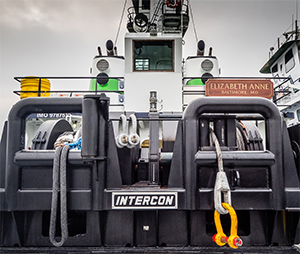 |
|
The 100-foot tug has an Intercon DD-200 double-drum towing winch wound with 2,500 feet of 2-inch wire on the main drum and 1,800 feet of 1.75-inch Spectra line on the secondary drum. |
The tug evolved from 15 Patapsco-class vessels built at Thoma-Sea Marine in Houma, La., and designed by Frank Basile’s company, Entech and Associates. “They’ve been tweaked and Vane has rearranged the engine room,” said Basile, who recently sold Entech to Kimia Jalili, who changed the name to Entech Designs.
The original Elizabeth Anne, named for the mother of Vane Brothers owner Duff Hughes, was refurbished in 1989 at Allied Shipyard in Larose, La. “We brought her back to Baltimore to start our tug fleet,” said Jim Demske, Vane Brothers port captain and head of new construction. In 2014, the company donated the tug to Kings Point Military Academy for use as a training vessel.
Unlike the Patapsco-class tugs fitted with nozzles and foil rudders, the Elizabeth Anne class has open, Hung Shen workhorse-type wheels and large shipyard-built barn door rudders.
“The Patapsco-class makes very good time and is very efficient with the nozzles,” Grover said. “But I think these boats will work very well underway and, like this boat, will be a great handling boat.”
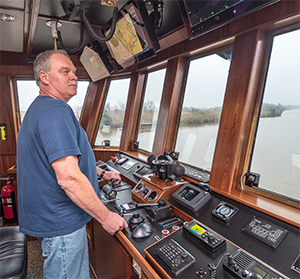 |
|
Capt. Darren Grover steering Elizabeth Anne along the Sabine River. |
Vane Brothers has not let up on the pace of new construction since the first Patapsco tug left Thoma-Sea in 2004. In 2008, the company contracted with Chesapeake Shipbuilding of Salisbury, Md., to build nine 94-foot, 3,000-hp Sassafras-class tugs. In 2014, Vane ordered four more from Chesapeake, the first of which, Kings Point, was delivered last year. Since 2004, 27 Patapsco-, Sassafras- and Elizabeth Anne-class tugs have been added to the fleet, and there are at least 13 more tugs to come.
Such growth does not go unnoticed by a shipyard when a Vane Brothers representative visits to discuss tug construction, and St. Johns Ship Building is not taking an eight-boat contract lightly.
“The yard did an excellent job and built a really solid tug,” Grover said. “The yard is very proud of the boat and did a great job of finishing the interior.”
There’s nothing like a comfortable helm chair on a long voyage, and Grover and crew appreciated the Llebroc model Demske ordered for Elizabeth Anne during the recent trip from Jacksonville. The chair is the nucleus of a pilothouse finished in rich, fine-grained and finely joined Sapele mahogany. “The carpenters at St. Johns may be some of the best I’ve ever worked with,” Demske said. “Anyone building a tug or supply boat would be damn lucky to have these craftsmen do their interior.”
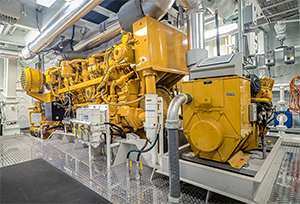 |
|
Backup power on Elizabeth Anne comes from two John Deere 4045 engines, installed next to the Caterpillar main engine. |
Since the Louisiana boats were built, Demske and Basile have collaborated on design improvements. The upper wheelhouse, a nest where the captain and mate dwell for long periods, now has taller windows, and the forward-facing windows have more angle to minimize reflection. The new design increases the diameter of the stanchions supporting the upper pilothouse, giving the tugs a more substantial look.
“They’re Entech’s design with input from me and the yards to refine and improve the boats from Frank’s originals,” said Demske. “There are a lot of subtle changes from the first ones at Thoma-Sea and later Chesapeake and now at St. Johns.”
Building so many boats with similar interior arrangements for the machinery spaces, crew quarters and the pilothouse offers familiarity for crewmembers moving from one boat to another. This feature is especially beneficial for the engineers working in engine rooms in different vessels.
“Those identical layouts can be a huge comfort when you’ve got to get a boat up and running at 3 in the morning on your first night aboard,” Demske said.
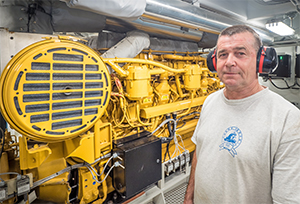 |
|
Chief engineer Kenny Mooney stands alongside a Caterpillar 3516C Tier 3 engine producing 2,100 hp. |
Consistent with the Louisiana-built boats, access to the upper pilothouse is by way of Lapeyre-style ladder stairs. Called the alternating tread stair, the Lapeyre stair is just that, a single-foot tread that alternates left and right to allow a comfortable face-forward descent with close-fitting handrails for support.
The vessel’s entire 24-inch perimeter sheer strake is wrapped with laminated fendering supplied by M&M Bumpers. The Bourg, La., company also supplied a typical model bow fender with a big bow pudding.
Elizabeth Anne is powered by Caterpillar 3516C Tier 3 mains with Reintjes WAF 873 reverse reduction gears. “The Reintjes gears on the 4,200-hp boats with their 7:1 ratio is almost the perfect combination with the Cat 3516 engines,” Demske said.
On deck, consistent with the Patapso boats, Elizabeth Anne is equipped with the massive Intercon DD-200 double-drum towing winch on the stern. The main drum is wound with 2,400 feet of 2-inch wire, and the secondary drum is wound with 1,800 feet of 1.75-inch wire, layered with 300 feet of 2-inch Spectra rope.
 |
|
Chief engineer Kenny Mooney, Capt. Darren Grover and deck hand Zack Richardson gathered around the bow H-bitt on Elizabeth Anne. |
Also on the aft deck is a Texas bar, fabricated at Turner Industries, and two 20-inch deck sheaves built at Main Iron Works in Houma, La. On the bow is a shipyard-built H-bitt that showcases a St. Johns Ship Building logo on each horn, a point of pride displayed atop all the bitts.
“Vane Brothers is especially pleased to have Darren Grover and Erik Hansen as alternate captains on this newest tug,” Demske said. “Both men are experienced sailors who left tugs they really enjoyed working aboard to take this newest challenge. The yard built a good tug but she will evolve, with these two crews, into a great tug with time.”
And the Vane Brothers program rolls along, launch after launch, currently taking up real estate at three shipyards. Hudson, the second tug in the Elizabeth Anne class was recently delivered from St. Johns Ship Building. Chesapeake Shipbuilding will deliver the 12th Sassafras-class tug, Fort McHenry, this summer, followed by Fishing Creek with at least another four to follow. And Conrad Industries is building three 110-foot, 4,400-hp ATB tugs at its Orange Shipbuilding yard.

